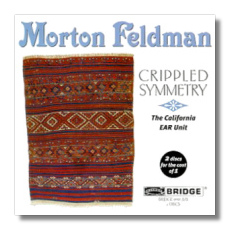
The Internet's Premier Classical Music Source
Related Links
- Feldman Reviews
- Latest Reviews
- More Reviews
-
By Composer
-
Collections
DVD & Blu-ray
Books
Concert Reviews
Articles/Interviews
Software
Audio
Search Amazon
Recommended Links
Site News
 CD Review
CD Review
Morton Feldman

Crippled Symmetry
Members of the California EAR Unit
(Dorothy Stone, flute & bass flute
Arthur Järvinen, vibraphone & glockenspiel
Vicki Ray, piano & celeste)
Bridge 9092 A/B DDD 2CDs 40:41, 46:46
Crippled Symmetry was one of Morton Feldman's late works; he wrote it in 1983, just four years before his death. At this point in his career as a composer, Feldman was interested in music that existed over long timespans… or perhaps it is more accurate to say that he was interested in musical material and instrumental combinations that required long timespans in order to come to fruition. One notorious example is the Second String Quartet, which requires six hours in a complete performance. One of Feldman's goals was to create the illusion of immobility in his music, just as painter Mark Rothko (a Feldman favorite) created the same illusion in his megalithic canvases. Long timespans also assisted him in creating the desired sensation of stasis. Music writer Norman Lebrecht described one of his works as dwelling "between the hypnotic and the soporific." If Brownian motion has a soundtrack, Feldman wrote it.
Next to the infamous quartet, Crippled Symmetry is a mere slip a work, music that goes by in a heartbeat. Feldman was fascinated by the designs in Turkish rugs. Their symmetry was never quite perfect; in other words, it was crippled. Feldman realized this concept in musical terms. In Crippled Symmetry, musical patterns are held up to a subtly distorting mirror. Although Feldman's music doesn't sound anything like the minimalism of Philip Glass or Steve Reich (it's closer to the work of Eastern European "minimalists" such as Giya Kancheli, however), it requires a similar redefinition of what it means to listen. In this manner, Feldman proclaims his connections with John Cage, with whom he became acquainted in the 1940s.
So what does it sound like? Take a video camera and record a long pan of a landscape - let's say a forest with irregularly swaying trees, and the occasional beast running from behind one trunk to another. Next, play the tape back on your VCR. As you do so, turn your television on and off at fairly regular and short intervals, thereby creating series of gestures rather than continuous motion. At the same time, get a friend to slowly alter the color, tone, and contrast of the image on the television. (Remember those mornings when there was nothing good on TV, so you turned everyone green and pretended that you were on Mars?) It's a silly analogy, but it may be helpful to those who are unfamiliar with Feldman's music. What a strange journey it turns out to be. The composer's understanding of the instrumental timbres in Crippled Symmetry is uncanny; his combinations and juxtapositions blur the distinctions between the six instruments. At times, you may not know what you're listening to.
Stone, Järvinen, and Ray play this music with cool intensity; I particularly liked the sound of Stone's bass flute. Early in the (arbitrary) third section of the work, the music's already spare texture thins out to almost nothing, and then the moaning of Stone's instrument suggests a sickness unto death. Talk about "crippled." The engineering is fine; resist the temptation, however, to turn the volume too high. Bridge is offering these two discs for the price of one, so don't hesitate. Oh, this is wondrous strange.
Copyright © 2000, Raymond Tuttle




















